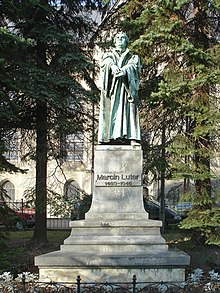Luther Monument (Bielsko-Biała)

The Luther monument in Bielsko-Biała ( Polish: Pomnik Marcina Lutra w Bielsku-Białej ) is the only Luther monument and statue in Poland today . It was built in 1900 and was the only statue of the reformer to remain undamaged after the Second World War .
history
background
The cities of Bielitz and Biala (Biała) as well as the villages in the surrounding area (today, for example, the urban area of Bielsko-Biała) were predominantly German populated until 1919 . In the Duchy of Teschen , the Reformation was initiated in 1545 by Duke Wenzel III. Adam officially introduced, but was common in Bielitz a few years earlier. Despite counter-reformist efforts, the Evangelical Lutheran faith remained important in the region. The churches of the two cities were built according to the imperial tolerance patent of 1781.
Strong population shifts occurred after 1919 and especially 1945 with the flight and expulsion of the German part of the population . The diocese of Cieszyn (Teschen) with its official seat in Bielsko-Biała is today the smallest of the six dioceses of the Evangelical-Augsburg (Lutheran) Church in Poland , in terms of percentage the Lutheran Christians still have a special position there.
Emergence

The model for the monument in the then Silesian Bielsko (Polish: Bielsko ) was the monument that the West Bohemian city of Asch (Aš) erected in 1883 for Luther on the 400th anniversary of his birthday. Today it is the only Luther monument in Bohemia . The sculptor was Hans Rößner from Nuremberg . Another monument in the Austro-Hungarian dual monarchy was executed by Gyula Schweiger in Budapest in 1894 . With its location in a building niche, however, this stone-carved Luther is far less prominent than the free-standing bronze versions .
350 years after the Teschen Reformation, the desire for a monument arose in Bielitz. The driving force was the Alexanderfeld textile manufacturer Heinrich Wilhelm Förster in 1892 . In 1897 a nine-member memorial committee was set up. The proposal to make a copy of the Asch memorial was not approved. Three artists submitted designs, two came from the capital Vienna , one from Nuremberg. The work of the Viennese sculptor Franz Vogl (1861–1921), who made a name for himself with the monument to Ferdinand Raimund in front of the Volkstheater in Vienna, was selected. The selected design was officially presented on November 10, 1897. Vogl also designed the system around the monument. From May to September 1900, all work on the monument was carried out. Theodor Gröger, a stonemason from Bielitz, made the granite plinth.
inauguration
The statue was ceremoniously unveiled on September 8, 1900. The celebrations began on September 6th with a feast for a thousand guests in the hall of the Schützenhaus. The following day there was a service and the Austrian section of the Gustav-Adolf-Werk met. In the evening, Hans Herrig's Luther Festival was performed in the Bielitzer Theater. On the last day the monument was inaugurated with a pageant, speeches and church service.
In 1945 soldiers of the Red Army shot the monument from its base; shortly afterwards it was restored.
Location and description
The monument was erected next to the Evangelical Augsburg Church of the Redeemer in Bielsko (Bielsko, Kościół Zbawiciela w Bielsku-Białej) . Today the square is named after Martin Luther (Plac Lutra Marcina) ; number 12 is the seat of the diocese. The reformer looks towards the city center. At that time it was planned that a spacious avenue would lead from the statue to the market square. These plans never came to fruition.
A full figure of Luther in a robe rises on a square, stepped granite base. The sculpture is 2.5 meters high and weighs 620 kilograms. The head is turned slightly to the sky. In front of the left foot, Luther holds a closed Bible in both hands.
The base is now provided with a panel in front of it with the inscription Marcin Luter 1483–1546 in Polish. The monument was entered with the church under the number A-122/04 on October 18, 2004 in the database of listed objects of the Silesian Voivodeship .
Others
Vogl's portrayal of Luther caused discussions at the time, and “Goethe's nose” and “Wagner's chin” were very much criticized. However, the artist was able to successfully defend his portrayal of the reformer. The monument was also the first to be erected in Bielsko. The church of Biala (Biała) , built in 1781, is now named after Martin Luther (Kościół Marcina Lutra w Bielsku-Białej) .
The Luther monument in Brieg , Silesia , was destroyed in 1945 by the Red Army. The monument in Gdańsk's Marienkirche was first a target figure for throwing stones in 1945, then "decorated" with a German steel helmet and finally removed.
literature
- Ewa Chojecka: Pomnik Marcina Lutra w Bielsku. Ośrodek Wydawniczy “Augustana”, Bielsko-Biała 2002.
- J. Polak: Z badań nad dziejami Bielska-Białej od XIII do XX wieku. Bielsko-Biała City Council, 2007, ISBN 978-83-6013660-7 .
- Walter Kuhn : History of the German language island Bielitz (Silesia). 1981.
Web links
- Pomnik Marcina Lutra w Bielsku-Białej. Information from the Beskydy regionon the Luther Monument (Polish)
- Useful information. Information from the Municipal Tourist Information Center (German)
- Pomnik Marcina Lutra w Bielsku-Białej . The monument on the Polish side of the Reformation Decade.
- Pomnik Marcina Lutra - Luther Monument na portalu polska-org.pl (Polish)
Individual evidence
- ^ Idzi Panic: Śląsk Cieszyński w początkach czasów nowożytnych (1528–1653) [History of the Duchy of Cieszyn at the beginning of modern times (1528–1653)] . Starostwo Powiatowe w Cieszynie, Cieszyn 2011, ISBN 978-83-926929-1-1 , p. 262-264 (Polish).
- ↑ Luther-szobor (Hungarian, accessed October 29, 2017)
- ^ Presumably Hans Rößner.
Coordinates: 49 ° 49 ′ 21.2 ″ N , 19 ° 2 ′ 27.9 ″ E

